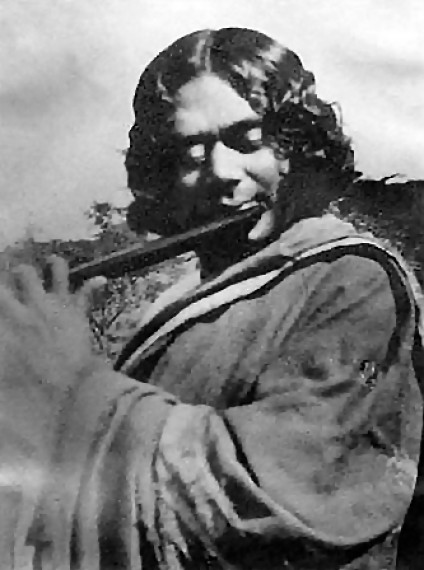
Kazi Najhrul Islam(part-3)

Around April-June 1921, Nazrul met the book publisher Ali Akbar Khan at the office of the Muslim Literary Society. With him he first came to Birjasundari Devi's house in Comilla. And here he met Pramila Devi with whom he first fell in love and later married.
But before that, Nazrul got married to Ali Akbar Khan's sister Nargis Asar Khanum. After the marriage contract was completed, there was a dispute in Nazrul's house in Kabin regarding the condition of staying as a son-in-law. Nazrul Ghar refused to stay as a son-in-law and left Nargis before Basar was completed and moved to Birjasundari Devi's house in Comilla town. At that time Nazrul was very ill and Pramila Devi took care of Nazrul. At some point they were married.[7]
Nazrul was a pioneer of communism. Despite being Muslim, she named her four children in both Bengali and Arabic/Persian languages. For example: Krishna Muhammad, Arindam Khaled (Bulbul), Kazi Sabyasachi and Kazi Aniruddha.[8]
Then the non-cooperation movement created great excitement across the country. Nazrul moved from Comilla to Ali Akbar Khan's house in Daulatpur for a few days and returned to Comilla on 19 June - during his stay he became an active political activist. His main job was to attend processions and meetings and sing. Some of the songs he composed and composed during that time include "Ae ko pagal pathik chulee elo bandini maar anginae, aji rakt-nishi vore/ Eki a Shuni Ore/ Mukti-Kolahal Bandi-Chainne" etc. Here he changed his place from 17 days. Returned to Comilla again in November 1921. On November 21 there was an all-India strike - on the occasion Nazrul again took to the streets; With non-cooperation processions around the city and chanting, "Bhiksha dao! Bhiksha dao! Phere chao ogo purvasi" - Nazrul's poems, songs and essays of this period revealed the feeling of rebellion. The best example of this is the poem called Rebel. The rebellious poem was published in 1922 AD and became popular in the literary community of India
Along with journalism, Nazrul was working in radio. At that time i.e. in 1942 he fell ill. He lost his speech. His illness was clearly known in July 1942 AD. He was then treated mainly with homeopathy and Ayurvedic treatment. But there was no improvement in his condition. At that time he could be sent to Europe for neurosurgery. But it was not possible because of the Second World War. By the end of 1942, he also lost his mental balance. After that the Nazrul family spent a lot of time in India. They remained in hiding till 1952. In 1952, the poet and his wife were sent to a mental hospital in Ranchi. An organization formed for Nazrul's treatment called the Nazrul Medical Committee played a leading role in this initiative, with the help of Shyamaprasad Mukhopadhyay, a famous Indian politician of the time. The poet stayed in Ranchi for four months.
Then in May 1953, Nazrul and Pramila Devi were sent to London for treatment. He left Howrah railway station for London on May 10. After reaching London several specialist doctors tried to diagnose him. Among them were: Russell Brain, William Segient and MacKiss - they met Nazrul three times. They were paid £250 for each session. According to Russell Brain, Nazrul's disease was incurable and impossible to cure. A group diagnosed Nazrul as suffering from "involutional psychosis". Besides, Indian doctors living in Calcutta also formed a separate group. Both groups agreed that early treatment of the disease was inadequate and inadequate. At the London Clinic in London, Kabir underwent an X-ray called air encephalography. It shows that the frontal lobe of his brain has shrunk. A number of doctors like Dr. McKisk saw fit to perform a procedure called the McKisk operation. However, Dr. Brain opposed it.
This time Nazrul's medical report was sent to famous doctors in Vienna. It was also sent to other important places in Europe. Roentgen, a professor of neurosurgeon at the University of Bonn in Germany, opposed the MacKiss operation. Doctors in Vienna also objected to this operation. They all refer to another test in which X-ray-visible dyes are taken in the blood vessels of the brain (cerebral angiography) - at the behest of the poet's well-wishers, he was admitted under the Viennese physician Dr. Hans Hoff. This doctor is one of the students of Nobel laureate physician Julius Wegner-Jauregg. The poet was examined on December 9, 1953. Dr. from the results. Hoff said the poet was definitely suffering from a neurodegenerative disorder called Pix's disease. The frontal and lateral lobes of the brain shrink in patients with this disease. He further said that it is impossible to cure the poet from the present condition.On December 27, 1953, Calcutta daily Jugantar Patrika published an article titled Nazrul in Vienna, authored by Dr. Ashok Bagchi - who was staying in Vienna for higher studies and had direct knowledge of Nazrul's treatment. However, British doctors demanded huge fees for Nazrul's treatment whereas no doctor in other parts of Europe charged. Soon Nazrul returned home from Europe. After that West Bengal Chief Minister Dr. Bidhan Chandra Roy went to Vienna and Dr. Hear the details from Hans Hoff. All those who accompanied Nazrul to Europe left Rome on 14 December 1953.[9]
.
